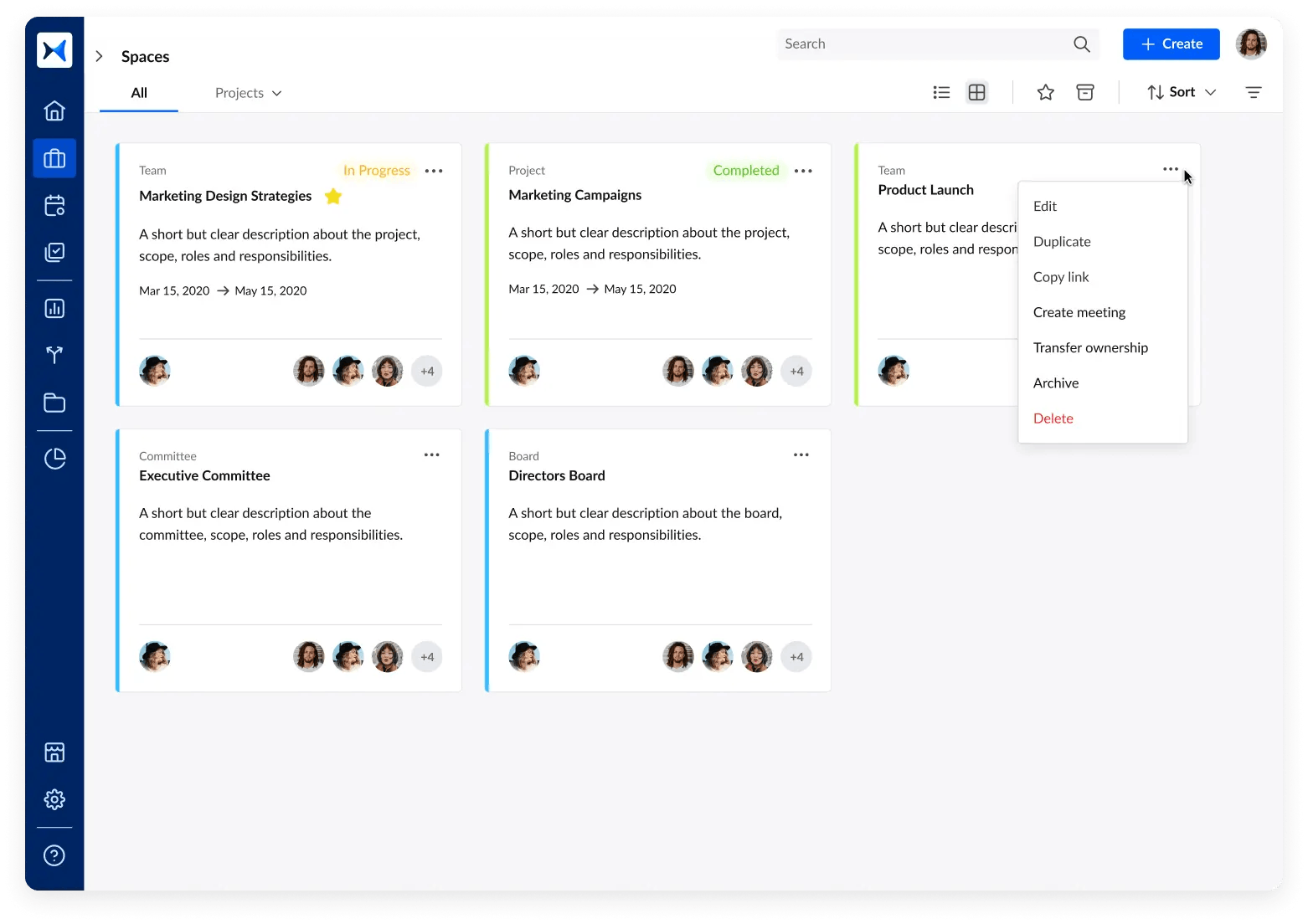November 4, 2024 · 9 min read
Best Practices for Managing Cross-Functional Project Meetings

Shaimaa Badawi

Cross-functional project meetings are where diverse ideas, expertise, and goals converge to drive innovation and problem-solving. But managing these meetings effectively isn’t always easy. From aligning different priorities to ensuring clear communication, the stakes are high. This guide will take you through the unique challenges of cross-functional meetings and the best practices to ensure every session is productive and impactful.
What are cross-functional project meetings, and why are they important?
Cross-functional project meetings bring together individuals from different departments or areas of expertise to collaborate on a shared project goal. Unlike regular team meetings, which typically involve members from the same function, these meetings leverage diverse perspectives and skills, ensuring that every aspect of a project, from strategy to execution, is addressed comprehensively.
The importance of cross-functional project meetings lies in their ability to bridge organizational silos. By aligning team members from various functions, these meetings foster better communication, reduce redundancies, and encourage innovative solutions. They provide a platform for departments like marketing, engineering, and operations to share updates, address interdependencies, and make collective decisions that impact the project's success.
Cross-functional meetings are critical for keeping everyone on the same page, mitigating risks, and ensuring that the project stays aligned with overarching business objectives. Their collaborative nature not only enhances problem-solving but also builds stronger, more cohesive teams capable of driving successful outcomes.
What challenges do cross-functional meetings typically face?
Cross-functional meetings are inherently complex, as they involve participants from diverse departments with different priorities, communication styles, and work methodologies. Here are some common challenges and their implications:
- Role ambiguity: Without clearly defined roles, participants may overlap in responsibilities or disengage, assuming others will handle key tasks. This leads to confusion and inefficiencies during and after the meeting.
- Competing priorities: Participants often bring their departmental goals to the table, which may conflict with the project’s collective objectives. Balancing these priorities can be difficult, especially without a strong facilitator.
- Communication barriers: Differences in jargon, terminology, or communication styles can result in misunderstandings. When departments operate in silos, it’s easy for misalignment to occur during discussions.
- Lack of engagement: Team members unfamiliar with each other’s workflows may struggle to participate meaningfully, leading to passive attendance rather than active contribution.
- Scheduling conflicts: Coordinating across departments often means juggling different timelines and workloads, making it hard to find a time that works for everyone.
- Decision-making bottlenecks: Without a clear structure for decision-making, discussions can become prolonged, with no actionable outcomes, which delays progress.
How can you prepare for successful cross-functional meetings?
Preparation is the backbone of a successful cross-functional meeting. With participants coming from diverse departments, ensuring clarity, focus, and alignment before the meeting begins is critical. Here’s how you can prepare effectively:
1. Define the meeting's purpose and objectives
Clearly outline what the meeting aims to achieve. Whether it’s decision-making, brainstorming, or progress tracking, having a well-defined purpose ensures all participants know the meeting's focus.
2. Select the right participants
Invite only those whose expertise or input is directly relevant to the meeting's goals. A smaller, focused group reduces distractions and keeps discussions efficient.
3. Create and share a structured agenda
A detailed agenda with allocated time slots for each discussion point keeps the meeting on track. Share it in advance to give participants time to prepare and contribute meaningfully.
4. Assign roles
Clearly designate roles, such as a facilitator to guide the discussion, a note-taker to capture key points, and individuals responsible for presenting updates or data.
5. Set expectations for participation
Inform attendees of what’s expected of them, whether it’s bringing data, preparing updates, or brainstorming ideas. This ensures everyone is ready to contribute.
6. Organize relevant materials
Gather and share documents, reports, or visual aids that will be discussed. Providing this context beforehand allows participants to come informed and ready to engage.
7. Test tools and technology
If the meeting involves video conferencing, shared documents, or specialized tools, ensure they are functional and accessible to all participants.
What best practices can improve cross-functional meeting outcomes?
Cross-functional meetings succeed when they are organized, inclusive, and action-oriented. Here are some best practices to ensure productive and impactful outcomes:
1. Start with a clear agenda
A well-structured agenda sets the tone for the meeting. Use a question-based format to spark discussions and allocate specific times for each item to maintain focus and efficiency.
2. Encourage active participation
Create a safe environment where everyone feels encouraged to share their insights. Use open-ended questions, acknowledge contributions, and ensure that no single voice dominates the conversation.
3. Define roles and responsibilities
Assign clear roles, such as a facilitator to guide the meeting and a note-taker to document decisions and action items. Also, clarify project roles to eliminate confusion and duplication of efforts.
4. Focus on decision-making
Avoid letting meetings drift into information-sharing sessions. Prioritize actionable decisions and establish a framework for resolving conflicts or reaching consensus.
5. Set measurable goals
Define specific objectives and outcomes for the meeting, such as agreeing on timelines or assigning tasks. Ensure these goals align with the broader project objectives.
6. Leverage visual tools
Use shared dashboards, charts, or whiteboards to present updates or brainstorm ideas. Visual aids help clarify complex topics and keep participants engaged.
7. Foster accountability
Conclude the meeting by summarizing decisions, assigning clear action items, and setting deadlines. Follow up to ensure tasks are progressing and outcomes are achieved.
8. Evaluate and adapt
Regularly gather feedback on meeting effectiveness and adjust your approach as needed. This iterative process helps refine future meetings and fosters continuous improvement.
How can tools and technology optimize cross-functional meetings?
Modern tools and technology are pivotal in enhancing the efficiency and effectiveness of cross-functional meetings. They streamline communication, improve task management, and ensure that every participant is aligned and engaged. Here's how they contribute:
1. Streamlined communication
Tools like video conferencing platforms (e.g., Zoom, Microsoft Teams) ensure seamless interaction for teams spread across different locations. Real-time chat and messaging apps facilitate quick exchanges during and between meetings.
2. Centralized information sharing
Shared document platforms like Google Workspace or Microsoft 365 allow participants to access and edit meeting materials simultaneously. This ensures that everyone is working with the same up-to-date information.
3. Enhanced agenda management
Meeting management platforms enable teams to create and share structured agendas. These tools help allocate time slots for each discussion point and keep meetings focused on their objectives.
4. Real-time collaboration
Interactive tools, such as digital whiteboards (e.g., Miro, MURAL), foster brainstorming and collaborative problem-solving. Teams can visually map out ideas and workflows, increasing engagement and clarity.
5. Automated task tracking
Project management software like Asana, Monday.com, or Trello integrates seamlessly with meeting platforms to assign tasks, set deadlines, and track progress post-meeting. This eliminates the risk of forgotten action items.
6. Meeting analytics and insights
Advanced platforms provide analytics on meeting frequency, duration, and outcomes. These insights help teams identify inefficiencies and refine their meeting practices.
7. AI-powered features
AI-driven tools offer functionalities like automated note-taking, action item tracking, and intelligent reminders, reducing administrative burdens and ensuring follow-ups are timely and effective.
What are the key follow-up steps after cross-functional meetings?
The success of a cross-functional meeting doesn’t end when the discussion concludes. Effective follow-ups are essential to ensure that decisions are implemented and progress is tracked. Here are the critical steps to take after the meeting:
1. Send a meeting summary
Share a concise summary or meeting minutes with all participants. Include key decisions, discussion points, and action items, so everyone is aligned on the outcomes.
2. Document action items
Clearly list the assigned tasks with specific deadlines and responsibilities. Use task management tools to track these items and provide a centralized view of ongoing work.
3. Update project stakeholders
Inform relevant stakeholders who couldn’t attend the meeting about the outcomes. This ensures transparency and keeps everyone in the loop about project progress.
4. Monitor progress on action items
Regularly check on the status of assigned tasks and provide reminders for approaching deadlines. Encourage team members to flag any blockers or dependencies early.
5. Provide access to resources
Ensure that all meeting-related materials, such as presentations, documents, or reports, are easily accessible to participants through a shared platform.
6. Evaluate the meeting’s effectiveness
Gather feedback from participants to assess whether the meeting achieved its objectives. Identify areas for improvement and incorporate them into future meetings.
7. Plan the next steps
Use the outcomes of the meeting to schedule follow-ups or set the agenda for the next session. Ensure continuity by linking the next meeting's goals with the previous one’s results.
How does adam.ai enhance cross-functional project meetings?
adam.ai is a comprehensive meeting management platform designed to enhance the efficiency and effectiveness of cross-functional project meetings. It offers a suite of features that streamline the entire meeting lifecycle, from preparation to follow-up, ensuring that teams collaborate seamlessly and projects progress smoothly. Here's how adam.ai contributes to successful cross-functional project meetings:
1. Structured agenda creation
With its agenda builder, adam.ai enables users to craft detailed agendas, assign speakers, and allocate time slots for each discussion point. This structured approach ensures that meetings remain focused and productive.

2. Real-time collaboration tools
The platform supports real-time polls, decision recording, interactive cross-references, and comments, fostering an interactive environment where all participants can actively contribute, regardless of their department.

3. Action management and delegation
The platform allows for the assignment, delegation, and tracking of tasks with detailed information, enhancing accountability and ensuring that decisions made during meetings are translated into actionable steps.

4. Meeting minutes generation and approval cycle
adam.ai simplifies the documentation process by automatically recording meeting minutes, summarizing discussions, and capturing key decisions. This ensures that no critical point is missed and provides a clear reference for follow-up actions.

5. Multi-space management
The platform enables users to link meetings to specific projects, teams, committees, or boards, providing a uniform meeting practice and comprehensive documentation of meeting history, content, and interactions. This organization facilitates better tracking of progress and decision-making across various cross-functional initiatives.

Transform how you conduct critical meetings—From meticulous preparation to effective execution and insightful follow-up, adam.ai integrates comprehensive analytics, full customization, and intuitive interfaces with powerful meeting management tools.
Easy onboarding. Enterprise-grade security. 24/7 dedicated support.
The bottom line
When managed well, cross-functional meetings become a catalyst for innovation and teamwork, bridging departmental divides to achieve common goals. By applying the right strategies and leveraging modern tools, these meetings can transform challenges into opportunities, ensuring your projects stay on track and deliver exceptional results.
And while there may be multiple solutions available, here is why adam.ai is the meeting management software platform you can trust:
- adam.ai is one of Atlassian Ventures' portfolio companies.
- In the meeting management software category on G2, adam.ai has been ranked a leader and a high performer for successive quarters in the past years.
- adam.ai has been included in the Forrester Report in the AI-enabled meeting technology landscape.
- adam.ai is trusted and used by powerful teams and organizations worldwide for all types of critical meetings, like board, committee, project management, and business development meetings.
- And most importantly, adam.ai integrates with your existing workflow, is SOC2 compliant, provides dedicated support and success, and has a free trial option.
Subscribe to adam.ai blog
Stay ahead with the latest insights—get our newest blog posts, tips, and updates sent straight to your inbox.